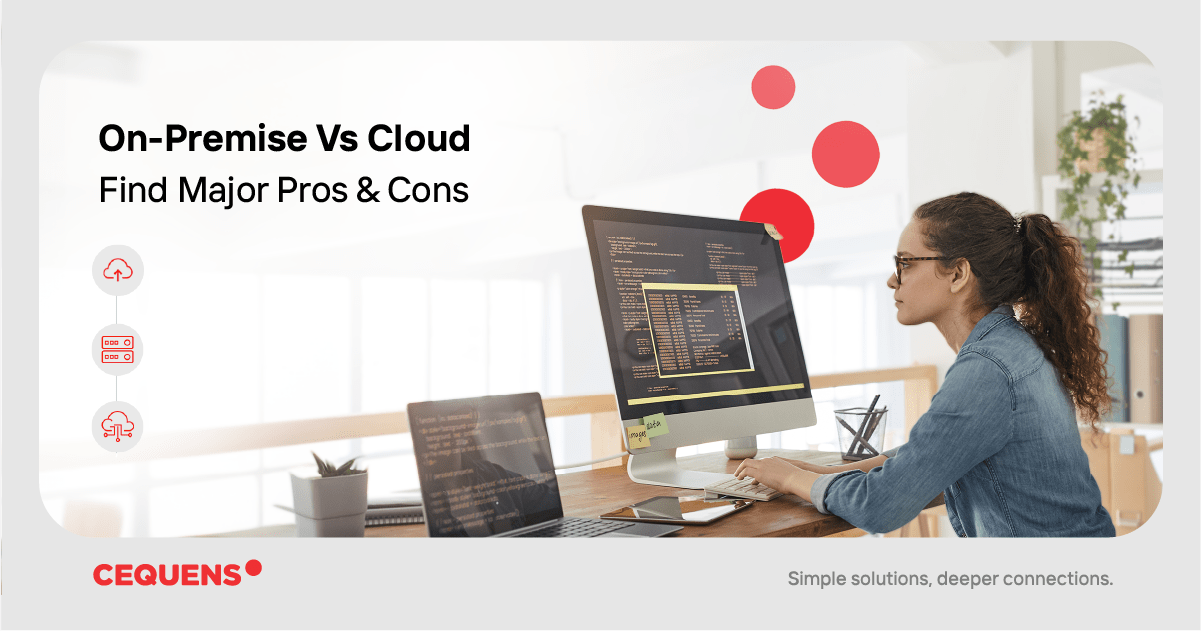

 Business Partner |
Business Partner | 

As digital transformation is leaving no stone unturned, businesses are faced with the seemingly simple question of which platform to adopt for their next suite of systems. Whether on-premises or cloud solutions, each option carries its distinct set of pros and cons, influencing factors like cost, scalability, security, and maintenance.
Cloud-based productivity software has expanded rapidly as 94% of enterprise businesses adopt cloud-based systems according to RightScale. However, not everyone is as eager to make the switch, and there are some very valid reasons to keep your servers on the ground. This detailed guide offers a deep understanding of both cloud and on-premises approaches, carefully evaluating their advantages and disadvantages to empower businesses in making well-informed decisions.
The way businesses communicate with their customers either fuels growth or slows it down. Utilizing the suitable communication solution for your business definitely leads to higher conversions, retention, and business growth. There are many communication platforms that are highly scalable and provide seamless customer experiences such as CEQUENS Omni-Channel Chat, Zendesk, and Salesforce. And in the world of internal communications, there are also certain empowering communication solutions such as Microsoft Teams, Slack, Trello, Google Workplace, and many other platforms that businesses use worldwide to boost their employees' development. There are two approaches that businesses choose according to their industry and needs: cloud solutions and on-premises solutions.
Infrastructure location is the key factor that distinguishes cloud solutions from on-premises solutions. Cloud solutions (aka cloud computing) are hosted on a service provider’s servers and its accessibility depends on internet connectivity. On-premises solutions, on the other hand, are hosted on the company's own servers, giving it complete control over all maintenance, updates, and management of the infrastructure and resources needed to operate the software or hardware.
Cloud computing provides a wide array of computing services such as storage, processing power, and software, and all these services are provided over the internet on a pay-as-you-go basis. This enables more mobility and flexibility of use for cloud-based software options. Many businesses are switching or have already switched to cloud solutions for the cost-efficiency, scalability, and agility they offer. It is worth mentioning that the global public cloud computing market is steadily expanding and is projected to reach an estimated value of $679 billion in 2024 according to Statista.
On-premises solutions are software solutions hosted in-house, requiring local ownership of data, hardware, and software, running on machines within your facility without third-party access. On-premises solutions represent the traditional approach to deploying and managing IT infrastructure and software. This approach provides businesses with an exceptional degree of control over their hardware, software, and data assets, allowing them to fine-tune the infrastructure to meet their specific needs and security protocols. By keeping essential systems on site, companies foster a sense of proximity and accessibility, leading to more customized management practices and smooth integration of capabilities.
It is worth highlighting that IT professionals worldwide anticipate a near-even split between on-premises and cloud solutions within their organizations, resembling a 50/50 balance. This trend is expected to continue through 2024, with only a slight decline projected in the share of physical machines and virtual servers managed on-premises.
A hybrid cloud combines private and public cloud services, offering flexibility and scalability. Some data stays on-premises for security, while other workloads utilize the public cloud's scalability and cost-effectiveness. This approach allows for easy data migration and workload portability, providing agility and control. It helps businesses optimize IT infrastructure, improve efficiency, and meet regulatory requirements.
Each business has its own needs which might go perfectly with cloud or on-premises solution. It is your business's call to determine which solution is more suitable for you. However, there are industries who made their stance clear on which solution that seems to be rewarding for them.
1. Banking and financial services
One of the most critical industries that cannot compromise security, yet they chose a middle ground to make the most of the cost-efficiency and scalability of cloud solutions through mobile applications and websites, while keeping critical financial data on-premises for ultimate security and control. Some of the outstanding business models in banking cloud adoption are Capital One, HSBC, and Bank of America that built its own cloud leading it to save $2 billion.
2. Retail
Cloud solutions dominated the retail vertical without question especially since the evolution of e-commerce that needs seamless inventory management and data analytics. According to Grand View Research, the global retail cloud market was valued at approximately USD 50.09 billion in 2023 and is expected to expand at a compound annual growth rate (CAGR) of 18.7% from 2024 to 2030.
3. Healthcare
Cloud solutions are becoming more prominent in healthcare with 50% adoption rate more than other verticals. Cloud computing is empowering medical applications like telemedicine, electronic health records (EHR), and medical imaging, providing remote access to patient information and enhancing collaboration among healthcare providers.
4. Marketing and advertising
Marketing and advertising agencies utilize cloud computing for functions including data analytics, campaign management, and customer engagement platforms. Cloud services enable them with instant insights and collaboration with remote teams, leading to enhanced campaign performance and increased return on investment (ROI).
|
Cloud solutions pros |
On-premises solutions pros |
|
|
|
Cloud solutions cons |
On-premises solutions cons |
|
|
Ultimately, the decision between cloud or on-premises solutions depends on various factors like business goals, budget constraints, security needs, and scalability requirements. While cloud solutions offer flexibility, cost-efficiency, and scalability, on-premises solutions provide control, security, and customization. It is crucial for businesses to carefully assess their specific needs and weigh the pros and cons of each option before making a decision. If your business needs the most stringent security protocols and control over your data due to regulatory compliance issues, then an on-premises solution is likely your go-to. In many cases, a hybrid or multi-cloud strategy may offer the best of both worlds, combining the advantages of cloud and on-premises solutions to meet diverse business requirements.
To explore hybrid, seamless solutions for your business, schedule a demo today.
